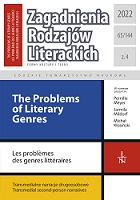„Rzuć K8 na inicjatywę”, czyli o narracji drugoosobowej w grach fabularnych
“Roll D8 for Initiative” - On Second-Person Narration in Tabletop Narrative Role-Playing Games
Author(s): Paulina SiedleckaSubject(s): Media studies, Communication studies, Sociology, Theory of Communication, Theory of Literature
Published by: Łódzkie Towarzystwo Naukowe
Keywords: second-person narration; tabletop role-playing game; RPG; Game Master;
Summary/Abstract: The aim of the article is to present the phenomenon of using the second-person narrative in tabletop role-playing games. Despite its ambiguous status in literary projects, the dyadic narrative is the basic component of the phenomenon of pen-and-paper RPGs. In the introduction, the author briefly introduces the specificity of text-based narrative games and the history of their creation. Then the most popular systems, such as Dungeons & Dragons or Vampire: The Masquerade, were characterized, as well as examples of games created in Poland. To illustrate the phenomenon, official manuals, and recordings of sessions of the most popular Polish artists published on YouTube were used. When discussing examples of second-person narration, the author draws attention to its occurrence in guides and in the statements of the player functioning as the Game Master. The Game Master is a specific narrator of heroes’ adventures, who in his action smoothly moves between different types of narratives (first, second and third person): he describes the scenery and actions of NPCs and creatures, constructs statements of characters not guided by other participants of the session, but also comments on the actions and commands of player-created heroes. It is precisely in this last type of activity that the dyadic narrative is extremely important. In the statements of the Game Master, it manifests itself primarily as a commentary on the actions of the characters, the continuation of the plot after the actions and statements of the players, and when consulting the heroes’ further actions, but also serves technical communication related primarily to the mechanics of throwing polyhedral dice. The use of a second-person narrative in RPGs primarily contributes to increasing the immersion, the involvement, and the sense of interactivity between players.
Journal: Zagadnienia Rodzajów Literackich
- Issue Year: 65/2022
- Issue No: 4
- Page Range: 125-137
- Page Count: 13
- Language: Polish

